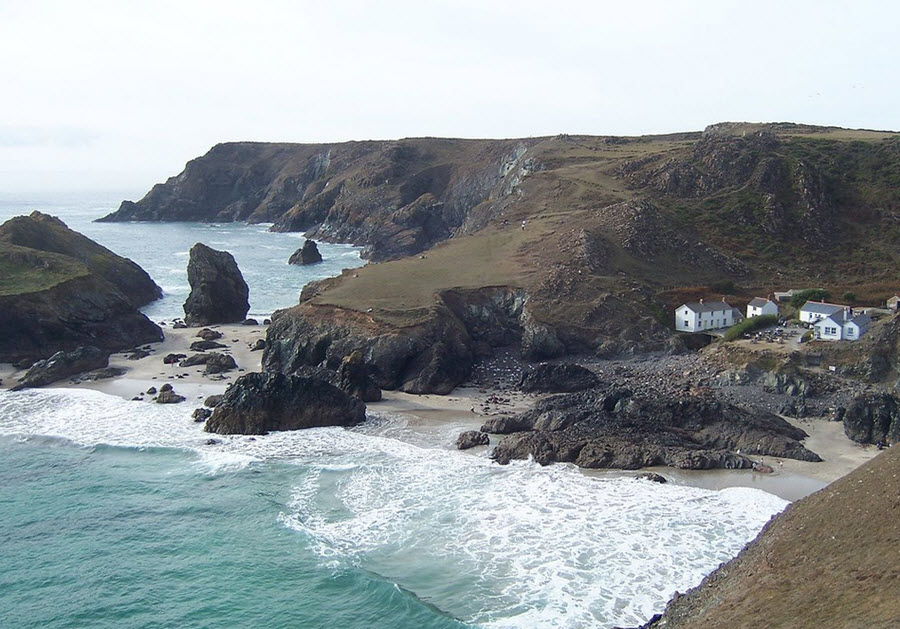Kynance Cove (Cornish: Porth Keynans) is a cove on the Lizard peninsula, roughly 2 miles (3 km) north of Lizard Point, on the eastern side of Mount´s Bay. It is within the Cornwall Area of Outstanding Natural Beauty.
During the early Victorian era, the cove experienced a surge in visitors – a part of a wider trend that involved visiting the Cornish coast from other parts of England. Among others, both Queen Victoria and Prince Albert visited the cove.
Today, Kynance Cove remains a popular destination for holidaymakers and is widely regarded as a very pretty stretch of coastline. The cove and its surrounding coast is owned and cared for by the National Trust, and is included in the West Lizard Site of Special Scientific Interest.

Practical info
- Coordinates: 49.974°N 5.230°W
- The National Trust run two toilets here; one in the car park and one by the café. Both are free to use.
- The Kynance Café was opened in the cove in 1929. It is still active, and is nowadays owned by the National Trust. Unsurprisingly, this place serves Cornish pasties, locally produced cider and excellent cream teas. The view from the café is spectacular.
Geology
There are two types of ophiolitic serpentine at Kynance: bastite and tremolite. Bastite is the dominating serpentine of the Lizard peninsula, while tremolite is more rare.
The cliffs to the south and the path to the cove are two examples of places where you can observe bastite serpentine. It is coarse-grained, and looks flecked due to the presence of large shiny crystals of bastite.
The stacks within the cove and the valley are of tremolite serpentine, and so are the small tidal islands in the cove. It is fine-grained and banded. Compared to bastite serpentine, the tremolite was subjected to higher pressure within the Earth´s crust.
Stacks and tidal islands
A long time ago, the tremolite serpentine was broken into blocks and invaded by other types of rock, including granite and basalt. Over time, the softer rocks were eroded away by the sea while the more resilient parts remained, which is how the stacks and tidal islands in the cove were formed.
The four largest stacks in the cove have names: The Bishop, Gull Rock (which is extra jagged), Asparagus Island ( Enys Merlosowen), and Steeple Rock. Steeple Rock towers above the beach in a dramatic fashion.
Asparagus Island – or Enys Merlosowen as it is named in Cornish – is cut off from the mainland almost every high tide. Around half-tide, a snorting can be heard from a blowhole on the island.
Caves
There are some caves around the beach which can be interesting to explore, but it is important to follow the recommendations and time it with the tide. If you don´t abide, you risk getting cut off by the rising tide and this can turn into a very dangerous situation.
Walks
The South West Coast Path
The famous South West Coast Path passes by on the cliffs overlooking Kynance Cove.
Lizard Point Walk
From Kynance Cove, it takes around 45 minutes to walk to Lizard Point. The path is rugged but doesn´t require any exceptional fitness level. Follow the path in a southerly direction from Kynance Cove; it is marked by acorn signs.
Mullion Cove Walk
The walking from Kynance Cove to Mullion Cove is approximately 7 kilometres (4.4 miles). It is a beautiful walk along a section of the Lizard coastline and around Predannack Head.
If you want to continue, you can proceed from Mullion Cove to Poldhu Cove.
Popular culture
- Kynance Cove can be seen in the 2015 BBC drama production based on Agatha Christie´s 1939 mystery novel about eight people who arrive on a small, isolated island off Devon.
- Kynance Cove is a recurring feature in the 2015 TV-series Poldark, as it is used for certain scenes near Ross Poldark´s beloved Cornwall estate.
- In the 1984 TV- series The Return of Sherlock Holmes, some scenes for the episode TheDevil´s Foot were shot at Kynance Cove.